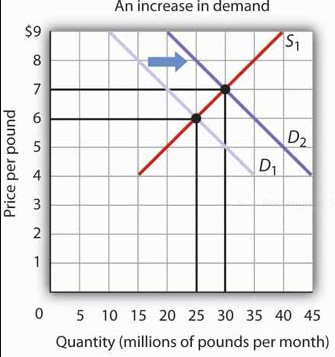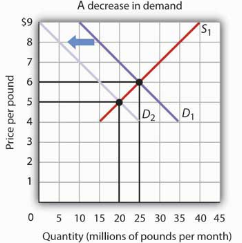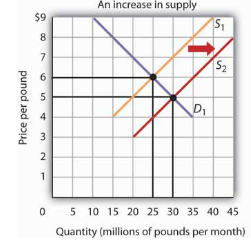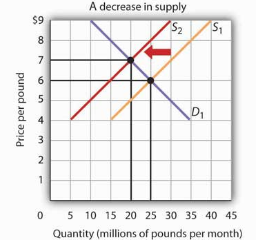Introduction
Demand and supply determine the prices of products and quantities manufactured and consumed. Consumers will exhaust the available supply of a product by buying a specific product at a high volume. It results in a rise in demand, which in turn decreases the available supply. The essay explores how to apply the concept of supply and demand analysis to bread as used daily our life.
Description of the Good, its Substitutes, and Compliments
Bread refers to food comprising flour that is moistened, kneaded into dough, and fermented applying yeast. In addition, it has been key nourishment from the prehistoric era. Fresh bread typically presents a pleasing brownish and crunchy crust, a pleasantly toasty aroma, a soft and elastic crumb texture, fine slicing features, and a moist mouthfeel. Bread has several substitutes comprising oatcakes, oat pancakes, cereals, wraps, salad, grilled proteins, eggs, Karelian pastries, flatbreads, and wholegrain crackers. Complementary goods provide value to another good; therefore, they are consumed together (De Boni et al., 2019). They are two products that a consumer uses in conjunction with each other; for example, bread and butter, bread and peanut, and bread and jam.
A Normal Good versus an Inferior Good
Normal goods refer to types of products whose demand exhibits a direct correlation with the income of a consumer. Hence, the demand for these goods increases as the income of a consumer increases or improvement in the economy. However, inferior goods refer to those whose demands decline when the income of people rises. In the case of bread, it falls under a rare type of inferior goods known as giffen goods because it is a staple in human being nutrition. The demand for bread typically rises when the rate of employment is at a low and high level of poverty (Opuni, 2017). Nevertheless, as consumers’ income rise, almost consistently more meat will be consumed than bread.
Non-Price Factors Affecting Demand
Several other non-price aspects, often known as underlying determinants, influence demand for bread, they include consumer needs, consumer income; consumer tastes, preferences, fashions; brand loyalty, and appearance habit. Consumers purchase bread out of habit and do not regard it as much. Consumers who prefer regional and local bread could be less price sensitive (Opuni, 2017). Manufacturers need to consider the size of the loaf based on the alteration in eating habits.
Consequently, since bread is an inferior good, when there is a rise in income consumers may reduce its demand. For example, people with low-income levels will demand more bread than meat. However, if they get a higher income, demand for bread may decline, while demand for meat is likely to increase. In addition, the price of substitute products may greatly influence the demand for bread. A rise in the price of the close substitutes may contribute to a rise in the demand for bread because consumers switch from the substitute good. For instance, an increase in the price of oatcakes is likely to lead to a rise in demand for bread (Xiao, 2017). In addition, many goods have complements, which are consumed together or required to make the good work.
Non-Price Factors Affecting Supply
The non-price aspects of supply that may affect the readiness of suppliers to produce bread are the expected future prices, production cost, technology, and the number of suppliers. When the labor, land, and capital costs are high, then the production cost of bread increases. It implies that suppliers may decrease their supply level as the cost to produce bread has increased. Further, businesses’ expectations concerning the price of bread may influence how much they supply. For example, if companies expect to receive higher prices for their bread next month, then they may decrease supply now and improve it in the next month to generate higher income (Brown, 2022). The opposite may happen if they anticipate prices of bread to drop in the future, suppliers may increase output before the prices decline.
Further, if there are many sellers and companies in the market, then the supply and level of bread output will rise. However, if there is limited competition in the market because of potential low-profit opportunities for companies, this contributes to fewer sellers; hence, a lower quantity of bread is supplied. Technology may be considered more efficient and effective, thus, permitting producers to increase their bread production and reduce labor costs. A rise in the technological level used in the company implies that the quantity of bread supplied will increase (Xiao, 2017). Nevertheless, if the company uses obsolete machinery, output levels may be low leading to the quantity of bread supplied being limited.
Changes in Demand Effects on the Equilibrium Prince and Quantity
An Increase in Demand
An increase in demand for bread shifts the demand curve to the rights, as illustrated in figure 1 below. The equilibrium price increases to $7 as the price increases to the new level of equilibrium, the quantity supplied increases to 30 million pounds of bread each month (Mapleton, 2018). However, the supply curve will not shift other than the movement along the supply curve.

A Decrease in Demand
A decline in demand for bread leads to a shift in the demand curve to the left. This contributes to the equilibrium price decreasing to $5. When the price decreases to the new level of equilibrium, the quantity supplied declines to 20 million pounds of bread as shown in figure 2 below.

Changes in Supply Affect the Equilibrium Price and Quantity
An Increase in the Supply
A rise in the supply of bread shifts the supply curve to the right, as demonstrated in figure 3 below. The equilibrium price decreases to $5 as the price decreases to the new equilibrium level, and the quantity of bread demanded increases to 30 million.

A Decrease in Supply
Figure 4 below illustrates that a decline in the supply of bread shifts the supply curve to the left; it leads to the equilibrium price increasing to $7. When the price increases to the new level of equilibrium, the quantity demanded declines to 20 million of bread monthly.

Based on my research on bread, I expect the demand for it over the next five years to increase because of the rising acceptance and convenience of bread in daily meals. This is the key factor, which currently drives the demand for bread in the bakery sector (Xiao, 2017). Further, the study reveals that there will be an increasing supply of bread due to the globalization of fast food and bread improvers.
Conclusion
Bread is an inferior good classified under giffen goods, even though it is nourishment to many people across the world. It has several substitutes and complements such as oatcakes, butter, and peanuts. Non-price factors that influence demand for bread are the price of substitutes and complements, consumer preferences, fashions, and tastes, consumer income, and expectations of consumers. Non-price factors that influence the supply of bread are production cost, suppliers, expected future prices, and technology.
References
Brown, C. (2022). Non-price factors of supply. Web.
De Boni, A., Pasqualone, A., Roma, R., & Acciani, C. (2019). Traditions, health and environment as bread purchase drivers: A choice experiment on high-quality artisanal Italian bread. Journal of Cleaner Production, 221(3), 249-260. Web.
Mapleton, C. S. (2018). Demand and supply: 500 practice problems solving for equilibrium (3rd ed.). Lulu. Web.
Opuni, F. (2017). Fundamentals of microeconomics. Key essentials of demand and supply analysis (7th ed.). GRIN Verlag.
Xiao, L. (2017). Theoretical comparison of supply side economics and demand side economics. New Supply Side Economics, 1(2), 1-29. Web.
